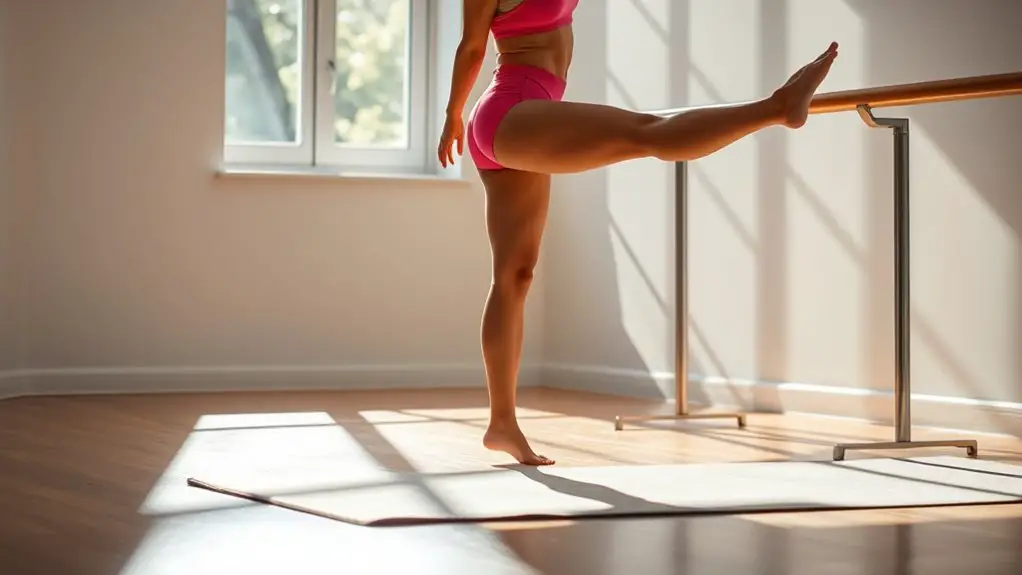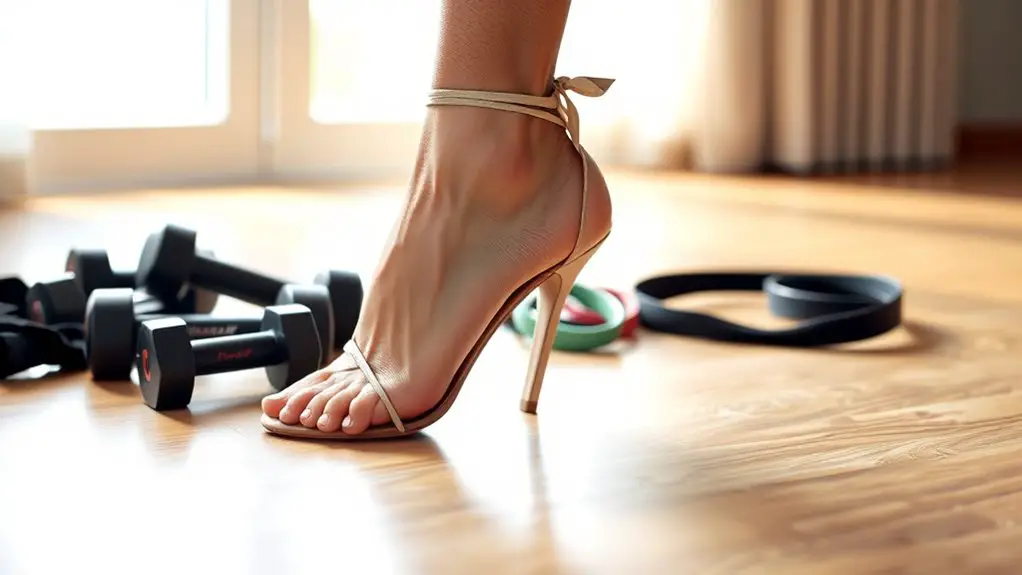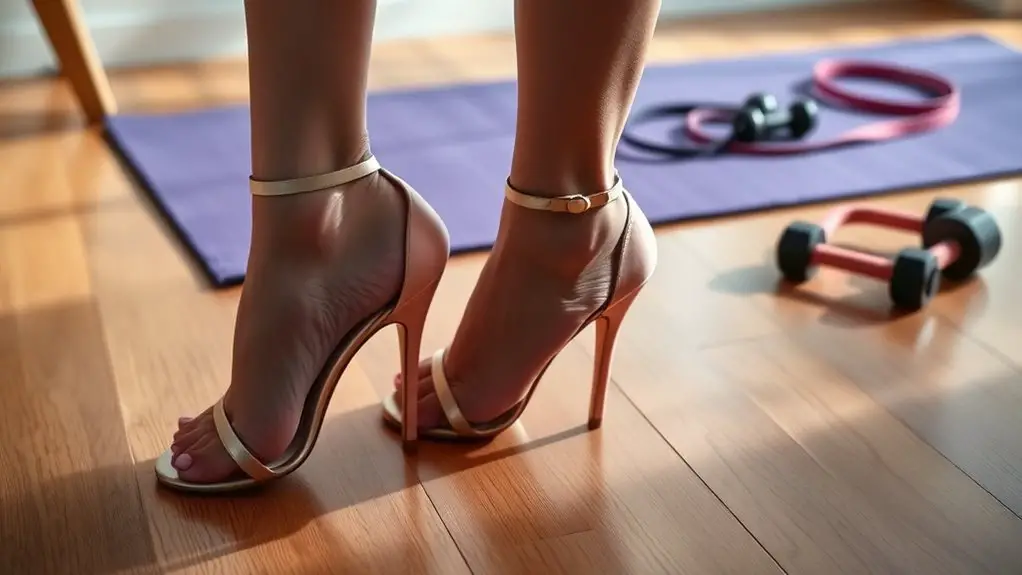To strengthen your ankles for high heels, incorporate targeted exercises like dorsiflexion, plantarflexion, eversion, and inversion with resistance bands, performing 3 sets of 10-15 reps. Enhance stability through balance training techniques, such as single-leg stands and heel-to-toe walks. Don’t forget to stretch before and after wearing heels—dynamic stretches warm up the ankles, while static stretches improve flexibility. Choosing supportive footwear is essential, and gradually increasing heel height can aid in building strength over time.
Ankle Strengthening Exercises

To enhance your ankle strength for wearing high heels, incorporating targeted exercises is essential. A focus on ankle mobility is vital, as it allows for a greater range of motion and stability while walking in heels. Begin with resistance band exercises: secure one end of a resistance band to a stable object and loop the other end around your foot. Perform ankle dorsiflexion by pulling your toes towards your shin, then return to the starting position. Next, try ankle plantarflexion by pushing against the band, pointing your toes away. Additionally, practice ankle eversion and inversion by moving your foot outward and inward against the band’s resistance. Aim for 3 sets of 10-15 repetitions for each exercise. Regularly incorporating these exercises will not only strengthen the muscles around your ankles but also improve your overall stability, making it easier to navigate high-heeled footwear confidently.
Balance Training Techniques
Strengthening your ankles is an essential step in preparing for high heels, but balance training techniques further enhance your stability and confidence while wearing them. Incorporating balance boards into your routine can greatly improve your proprioception and core stability. By standing on a balance board, you engage your ankle muscles and develop the necessary control to navigate uneven surfaces, which is vital when wearing heels.
Additionally, stability exercises such as single-leg stands or heel-to-toe walks can further challenge your balance. These exercises not only activate the stabilizing muscles around your ankles but also build neuromuscular coordination. Aim to hold each position for at least 30 seconds, gradually increasing the difficulty as your balance improves. Integrating these techniques into your training regimen guarantees you’ll feel more secure and poised in your high heels, ultimately reducing the risk of injury and enhancing your comfort level.
Stretching for Flexibility

Incorporating stretching into your routine is essential for enhancing flexibility, particularly when preparing to wear high heels. Effective ankle flexibility can be achieved through both dynamic and static stretches. Dynamic stretches, such as ankle circles and heel-to-toe walks, are beneficial before wearing heels, as they warm up the muscles and improve range of motion. Aim to perform these movements for 5-10 minutes, focusing on controlled motions that engage the entire lower leg.
On the other hand, static stretches should be incorporated after your activity. These include calf stretches and seated toe touches, held for 15-30 seconds. Static stretches help lengthen the muscles and improve overall flexibility, which is vital for ankle stability in high heels.
Proper Footwear Choices
How can the right footwear impact your experience in high heels? Selecting high heels with adequate ankle support is essential for both comfort and stability. Shoes designed with supportive straps or a structured ankle collar can greatly reduce the risk of sprains and injuries, especially during prolonged wear. Additionally, the materials used in shoe construction play an important role in your overall experience. High-quality leather or breathable fabrics can enhance comfort while allowing for proper foot movement.
When choosing high heels, consider those with cushioned insoles and shock-absorbing features, which can alleviate pressure on your feet and ankles. This combination of supportive ankle structures and appropriate shoe materials helps maintain your balance and posture, ultimately allowing you to enjoy high heels while minimizing strain. Prioritizing these factors will not only enhance your comfort but also contribute to the long-term health of your ankles.
Tips for Gradual Heel Height Transition

As you begin your journey into wearing high heels, gradually altering between different heel heights can help prevent discomfort and injury. A gradual increase in heel height allows your ankles to adapt, reducing strain on ligaments and muscles. Consider the following table for a structured approach to heel height adjustment:
| Week | Heel Height (inches) | Recommended Activities |
|---|---|---|
| 1 | 1-2 | Short walks, casual outings |
| 2 | 2-3 | Longer walks, standing events |
| 3 | 3-4 | Social gatherings, work events |
Start with a lower heel height and increase it weekly. Pay attention to how your body responds, allowing for rest days if discomfort arises. This method not only strengthens your ankles but also builds confidence in your heel-wearing ability.
Frequently Asked Questions
How Long Does It Take to Strengthen My Ankles for High Heels?
Strengthening your ankles typically takes 4 to 8 weeks with consistent ankle strengthening techniques. Incorporating high heel tips, like gradually increasing heel height, can enhance stability, ensuring your ankles adapt effectively to the demands of high heels.
Can I Wear High Heels Daily Without Ankle Issues?
You can wear high heels daily, but it’s essential to take into account ankle stability and heel height. Consistent use without proper support may lead to discomfort or injury, so gradually build your ankle strength for better endurance.
What Signs Indicate My Ankles Are Getting Stronger?
If your ankles feel more stable during balance exercises and you notice improved ankle mobility, you’re likely experiencing strength gains. Reduced pain or discomfort while moving also signals your ankles are adapting well to increased demands.
Are There Specific Heel Styles That Are Better for Ankle Support?
Certain heel styles, like block heels or wedges, provide better ankle stability due to their wider base. Lower heel heights also enhance support, reducing strain and improving your overall comfort when wearing heels.
Should I Consult a Doctor Before Starting Ankle Exercises?
Yes, you should consult a doctor before starting ankle exercises, especially if you’ve had previous ankle injuries. They’ll help guarantee you’re taking the right exercise precautions to prevent further damage while strengthening your ankles.



